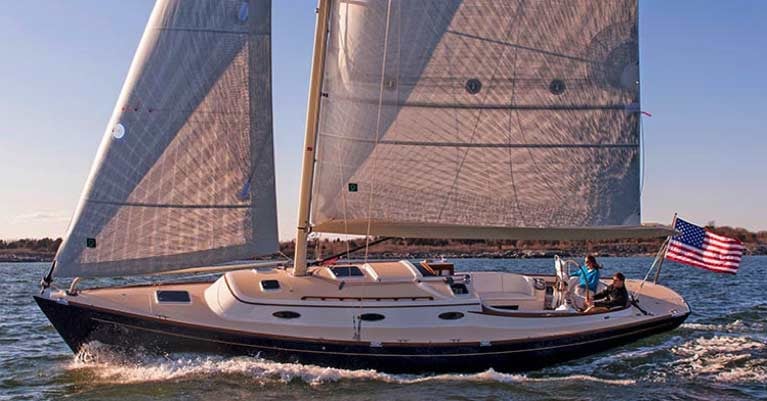Often cruising boat owners are unsure what type of upwind sails to order. Many would have received sails with their boat when it was bought new, and no doubt these would have been the primary crosscut Dacron sails. Below, Mark Mansfield, Olympian, sailing Professional/Coach and agent for Quantum Sails Ireland, outlines the four main options that are available when looking at new cruising sails.
To understand which option is best for a particular owner and boat, you need to know how different sail materials are made and so, the strengths and weaknesses involved in each can be seen. The three primary materials used in sails are:
- Dacron/Polyester sails
- Laminated sails
- Membrane sails
The costs increase as the sail material involves more exotic materials. Dacron is the least expensive, Laminated sails are more expensive, but sometimes not hugely so, and membrane sails usually feature Aramid and Carbon and are top of the line—and most costly. From these, there are four main options, with the Dacron sails having two options. I list these below.
1. Dacron Crosscut
This is the basic least expensive sail to produce and the material—Dacron—is the least expensive choice. If you only occasionally use the sails on your boat, a Dacron main or headsail is fine. However, after using it regularly, you will find the leech and luff stretching, resulting in the sail becoming baggier. This then makes it fuller, resulting in the boat becoming overpowered earlier, with earlier reefing needed.
 Quantum Cross cut Dacron sails—note panels parallel to foot
Quantum Cross cut Dacron sails—note panels parallel to foot
Because Dacron-- a woven material- is stronger sideways and up and down, when the load is in a diagonal direction, it stretches. Cross-cut sails generally run parallel to the foot, so as the loads come up the leech and up the luff, the loads can be in a diagonal direction and this means a cross-cut Dacron sail will stretch much earlier. Bottom line, a Dacron crosscut sail will likely need to be replaced earlier than any of the other 3 options below.
 Quantum Radial Dacron Main and headsail. Note panels in a radial fashion
Quantum Radial Dacron Main and headsail. Note panels in a radial fashion
2. Dacron, Radial sail
Ok, so we have discussed that Dacron does not like to be pulled in a diagonal direction. So the next best option is to use a good quality Dacron, but align the panels to the loads on the sail. This means instead of 10 panels or so in a cross-cut sail, 30 or more panels are used in a radial sail, to align the panels with the best strength characteristics of the Dacron woven cloth. As a result, these sails will stretch less and last longer. The downside is they take a lot longer to build and are therefore more expensive.
3. Laminated sails
We have already discussed that radial designed sails follow the loads on the sails better. Now the next option is going with a radial sail but instead of using a woven material, you use a laminated composite material. This cloth comes on a roll, like Dacron, but its construction is much more complicated, and various materials can be used in its construction, right up to Carbon. However, for Cruising sailors, the most popular laminated material is Contender CDX which offers a laminated option at a price point that is fairly attractive. Taffeta is included on both sides also for wear resistance.
Yes, this sail is a bit more expensive than the Crosscut Dacron, but similar in price to the Radial Dacron and will benefit from a longer usable life due to the superior quality material.
 Quantum radial laminated sails with Contender CDX Grey sailcloth
Quantum radial laminated sails with Contender CDX Grey sailcloth
4. Membrane sails
Virtually all Sailmakers offer their top Membrane sails for racing. However, these membrane sails are now finding their way onto cruising boats. Fusion M® cruising sails from Quantum utilise composite construction. They are engineered on a sail by sail basis as full-size membranes with custom fibre mapping tailored to the sail's design purpose and expected usage. They utilise a variety of fibre types. They provide lower stretch and greater strength, improving both initial performance and long-term shape retention without sacrificing durability and reliability.
These are top of the range sails and were you setting off for a long period and wanted to ensure your sails stayed together and with a good shape, the extra cost involved may be worthwhile. Likewise, if you occasionally raced, these sails would perform better.
 Quantum Fusion Membrane main and headsail
Quantum Fusion Membrane main and headsail
So, these are the four main options that clients choose from when ordering a new sail.
Popular options
The more popular options are options 1 and 3. Option one (crosscut Dacron) because of its low price and option 3 (laminated CDX) because of its competitive price plus superior quality material.


























































